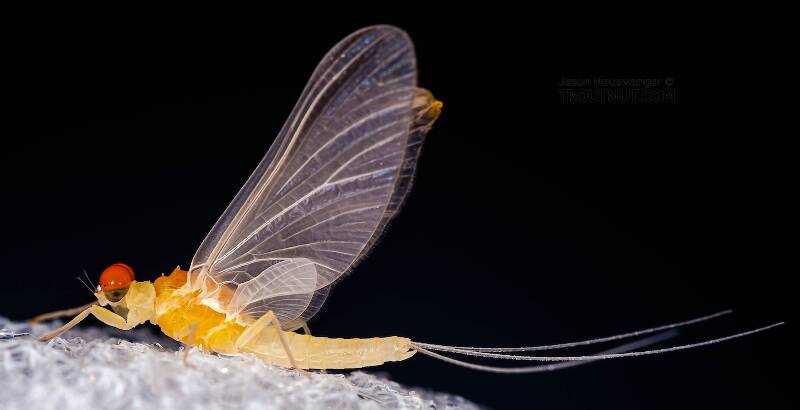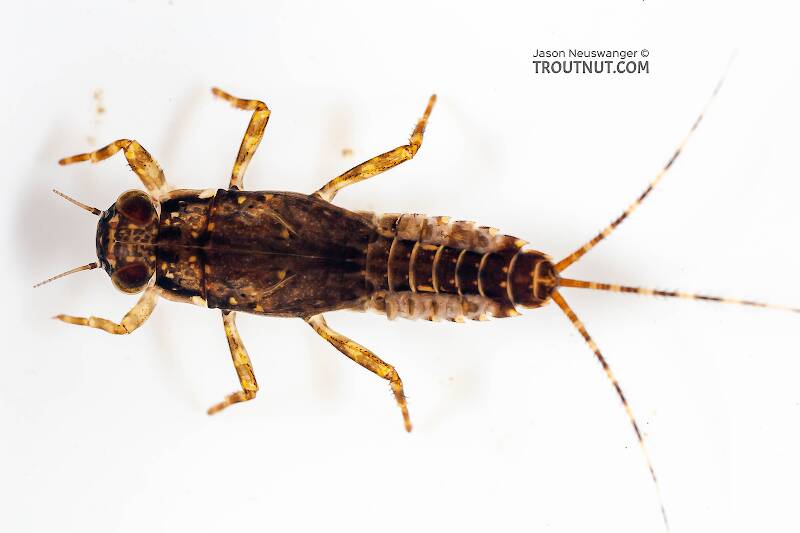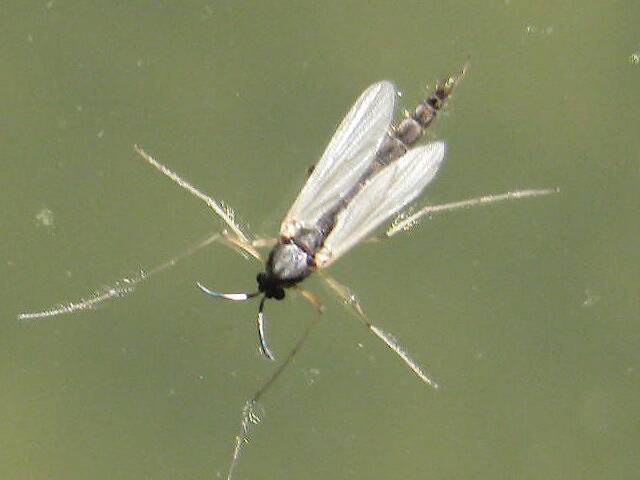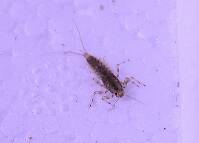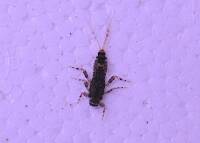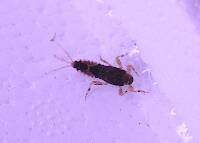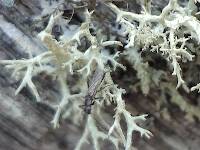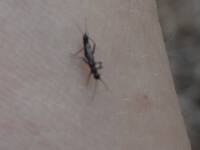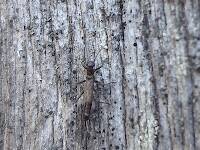
Hex Mayflies
Hexagenia limbata
The famous nocturnal Hex hatch of the Midwest (and a few other lucky locations) stirs to the surface mythically large brown trout that only touch streamers for the rest of the year.
Featured on the forum

This specimen resembled several others of around the same size and perhaps the same species, which were pretty common in my February sample from the upper Yakima. Unfortunately, I misplaced the specimen before I could get it under a microscope for a definitive ID.

Troutnut is a project started in 2003 by salmonid ecologist Jason "Troutnut" Neuswanger to help anglers and
fly tyers unabashedly embrace the entomological side of the sport. Learn more about Troutnut or
support the project for an enhanced experience here.
This topic is about the Mayfly Species Ephemerella dorothea dorothea
Ephemerella dorothea consists of two subspecies, which both produce excellent action. Ephemerella dorothea dorothea is a small species of Sulphur in the East, and Ephemerella dorothea infrequens (formerly Ephemerella infrequens) is one of the two main Pale Morning Dun hatches of the West. The remainder of this page focuses on the dorothea dorothea subspecies, and Ephemerella dorothea infrequens is discussed separately on its own page.This is one of the most challenging mayfly hatches on Eastern waters. On many streams, it follows or overlaps hatches of the larger, lingering Ephemerella invaria.
Example specimens
Konchu on Aug 12, 2007August 12th, 2007, 5:09 am EDT
I think that the invaria/rotunda problem is really interesting; it certainly caught my attention as a graduate student. It is a a topic that has permeated several discussion threads here. I'd like to make a summary of all the comments at some point, but not today. I look forward to some open-minded, constructive dialog that perhaps can lead to these problems being sorted out in a formal way.
Gene
Posts: 107
Posts: 107
Gene on Aug 12, 2007August 12th, 2007, 6:48 pm EDT
Gentlemen:
Thank you for your words however, I wasn't really defending myself. I just wanted to make sure that everyone knew I usually follow the standard procedure of always getting another expert's analysis and opinion especially on identification. Most people in the field do this. Also, I don't want people to think that anyone including myself is always right on anything especially on arbitrary things such as classification etc. I appreciate all the work that goes into this site and god knows this is a labor of love and you don't make much money with such a venture. I know because I have a number of sites for the love of fly fishing and aquatic entomology too. Another point on taxonomy and classification: I once sent the same 4 Stenonemas (now classified as Stenacron) to 4 different universities who were the tops in aquatic entomology. I got back 4 different identifications to species! Nature doesn't classify..but man does. But it's fun to do this stuff especially when they may mean something more important in water quality studies.
As far as the sulfurs go it will be interesting to see what happens over time (like in the next 5 years or so) because of global warming in freestone streams. For example, I was at Big Pine 6 weeks ago and it was in terrible shape. The stream doesn't hold (or receive) the water it once did and the temperature kept going into the 80's. What will this mean? I think that some species will start to disappear because they prefer colder water. We have a standard in the spring creeks of PA because of their constant temperature regime (46-50). This limits diversity but gives us large populations of a few mayflies, like the sulfurs. The freestone streams nearby also contain sulfurs but not in the quantity or do these streams usually have the long emergence period pattern of the spring creeks. E. invaria or rotunda whatever you call it is a very unique nymph. Why? Because it's only requirement is high oxygen. It is what I call a Superior Biological Indicator. It can live in just about any type of water from riffles to pools and on any substrate. Because of these factors when these mayflies start to disappear it means that there are usually serious problems in the stream. Many aquatic larvae are substrate specific so you can't really use them the way you would like. It will be interesting to see if other sulfur species move in for E. invaria.
I would invite all people who frequent this forum who have these flies in their streams to keep a close eye on their populations and patterns. They may serve as the best metric of what is really happening in our streams in the future.
As far as their coloration goes this is usually related to pH. If the stream is more alkaline the flies tend to be lighter colors in the wings especially. In waters below pH 7 and other's which are slightly acidic 6 to 7 these mayflies will have darker wings in the dun stage and may exhibit other color changes in the bodies and legs as well. This is a pretty good rule of thumb and works for most mayflies. For example, the Green Drakes from Kettle Creek are heavily colored on the wings as compared to the same species on Penns Creek due to pH differences. The Hendricksons on Kettle have almost black wings compared to the Hendricksons which still come off in small quantities on the Breeches which are light grey.
As far as emergence patterns go the sulfurs exhibit a number of different patterns dependent on the environmental conditions including wind, and temperature of the water and humidity. I've always thought the easiest trout fishing days occurred when they emerged quickly because the trout couldn't get that selective. But when you have high moisture and the duns ride the water long periods of time to dry their wings the fish get real smart real fast. On the spring creeks by the time the flies have emerged for a month or so the fish get so super selective many fly anglers wait till after dark to get any success.
Finally I have a theory which has little scientific merit to it but perhaps has just enough to make it hang around in my head. I actually believe that in many streams all 3 species of suflurs were present at one time. Over time the species evolved into one species and retains certain morphological characteristics and size graduations of all 3 species. Why do I say this because on Falling Spring the early sulfurs years ago were around size 12 and you might mistake them for Hendricksons. As the season progressed then characteristics and color patterns of routnda and dorothea appear. What gives me some weird reason to keep this theory around is this: spine patterns on the genitalia started with a certain small number like subvaria and increases as the year progresses like rotunda and invaria!
Of course, this would then lead one to believe if they could reproduce were they really separate species or maybe subspecies? Don't know but color wise and even morphologically these flies fit this! I have also seen this in other mayflies also including Stenonema and Stenacron. That's why it would be interesting to run DNA analysis on old samples going back 50 to 60 years that universities and museums had as their type specimens.
One other thing about sulfurs that I have noticed in the last 10 years is that the bright hot days cause them to emerge later and later in the day and into the night. That's why many hatch charts are so far off. They appear to like clouds more than the bright sun even on spring creeks. This is also true of spinner returns for these species which I have seen at 3:00 in the morning when temps cool down. I always wanted to ask my friend Ernie Schwiebert about this but his untimely death has left a real hole in the fly fishing world. He really had a detailed mind and he could probably comment on this from all the streams he had fished.
tight lines and big trout that rise
gene macri
Thank you for your words however, I wasn't really defending myself. I just wanted to make sure that everyone knew I usually follow the standard procedure of always getting another expert's analysis and opinion especially on identification. Most people in the field do this. Also, I don't want people to think that anyone including myself is always right on anything especially on arbitrary things such as classification etc. I appreciate all the work that goes into this site and god knows this is a labor of love and you don't make much money with such a venture. I know because I have a number of sites for the love of fly fishing and aquatic entomology too. Another point on taxonomy and classification: I once sent the same 4 Stenonemas (now classified as Stenacron) to 4 different universities who were the tops in aquatic entomology. I got back 4 different identifications to species! Nature doesn't classify..but man does. But it's fun to do this stuff especially when they may mean something more important in water quality studies.
As far as the sulfurs go it will be interesting to see what happens over time (like in the next 5 years or so) because of global warming in freestone streams. For example, I was at Big Pine 6 weeks ago and it was in terrible shape. The stream doesn't hold (or receive) the water it once did and the temperature kept going into the 80's. What will this mean? I think that some species will start to disappear because they prefer colder water. We have a standard in the spring creeks of PA because of their constant temperature regime (46-50). This limits diversity but gives us large populations of a few mayflies, like the sulfurs. The freestone streams nearby also contain sulfurs but not in the quantity or do these streams usually have the long emergence period pattern of the spring creeks. E. invaria or rotunda whatever you call it is a very unique nymph. Why? Because it's only requirement is high oxygen. It is what I call a Superior Biological Indicator. It can live in just about any type of water from riffles to pools and on any substrate. Because of these factors when these mayflies start to disappear it means that there are usually serious problems in the stream. Many aquatic larvae are substrate specific so you can't really use them the way you would like. It will be interesting to see if other sulfur species move in for E. invaria.
I would invite all people who frequent this forum who have these flies in their streams to keep a close eye on their populations and patterns. They may serve as the best metric of what is really happening in our streams in the future.
As far as their coloration goes this is usually related to pH. If the stream is more alkaline the flies tend to be lighter colors in the wings especially. In waters below pH 7 and other's which are slightly acidic 6 to 7 these mayflies will have darker wings in the dun stage and may exhibit other color changes in the bodies and legs as well. This is a pretty good rule of thumb and works for most mayflies. For example, the Green Drakes from Kettle Creek are heavily colored on the wings as compared to the same species on Penns Creek due to pH differences. The Hendricksons on Kettle have almost black wings compared to the Hendricksons which still come off in small quantities on the Breeches which are light grey.
As far as emergence patterns go the sulfurs exhibit a number of different patterns dependent on the environmental conditions including wind, and temperature of the water and humidity. I've always thought the easiest trout fishing days occurred when they emerged quickly because the trout couldn't get that selective. But when you have high moisture and the duns ride the water long periods of time to dry their wings the fish get real smart real fast. On the spring creeks by the time the flies have emerged for a month or so the fish get so super selective many fly anglers wait till after dark to get any success.
Finally I have a theory which has little scientific merit to it but perhaps has just enough to make it hang around in my head. I actually believe that in many streams all 3 species of suflurs were present at one time. Over time the species evolved into one species and retains certain morphological characteristics and size graduations of all 3 species. Why do I say this because on Falling Spring the early sulfurs years ago were around size 12 and you might mistake them for Hendricksons. As the season progressed then characteristics and color patterns of routnda and dorothea appear. What gives me some weird reason to keep this theory around is this: spine patterns on the genitalia started with a certain small number like subvaria and increases as the year progresses like rotunda and invaria!
Of course, this would then lead one to believe if they could reproduce were they really separate species or maybe subspecies? Don't know but color wise and even morphologically these flies fit this! I have also seen this in other mayflies also including Stenonema and Stenacron. That's why it would be interesting to run DNA analysis on old samples going back 50 to 60 years that universities and museums had as their type specimens.
One other thing about sulfurs that I have noticed in the last 10 years is that the bright hot days cause them to emerge later and later in the day and into the night. That's why many hatch charts are so far off. They appear to like clouds more than the bright sun even on spring creeks. This is also true of spinner returns for these species which I have seen at 3:00 in the morning when temps cool down. I always wanted to ask my friend Ernie Schwiebert about this but his untimely death has left a real hole in the fly fishing world. He really had a detailed mind and he could probably comment on this from all the streams he had fished.
tight lines and big trout that rise
gene macri
Wiflyfisher on Aug 13, 2007August 13th, 2007, 1:19 am EDT
When did DNA analysis start being used and is it absolutely accurate for identifying insects?
Gene, do you have a guess at what is the optimal temperature for E. invaria/rotunda to emerge?
Gene, do you have a guess at what is the optimal temperature for E. invaria/rotunda to emerge?
John S.
https://WiFlyFisher.com
https://WiFlyFisher.com
Martinlf on Aug 13, 2007August 13th, 2007, 9:10 am EDT
Great stuff, Gene. I especially found the comments on color interesting.
"He spread them a yard and a half. 'And every one that got away is this big.'"
--Fred Chappell
--Fred Chappell
Gene
Posts: 107
Posts: 107
Gene on Aug 13, 2007August 13th, 2007, 6:30 pm EDT
Gentlemen:
I think the that DNA species recognition will need to be done in the future if it hasn't already started in aquatic entomology. If you read the books you would think that this is cut and dried but it's not. The universities with the most power usually control the classification system in my estimation. There are exceptions. Identification and classification has always been a problem with mayflies for one reason: Biology of Mayflies by Needham, Traver, and Hsu which was from the 1930's I believe. Why? Because Needham was a fly fisherman. Look at the descriptions of those insects! I have never ever found such a delineation of detail for any other group of insects! Color was very important back then and it remains so today ...even if it may blind us to other things! There has always been a holy alliance between aquatic entomology and fly fishing!
As far as the specific temperature for emerging sulfurs I believe that there are a ton of variables here. Spring creeks are different from freestone streams sometimes. In a spring creek everything is controlled by sunlight because the stream has a constant temperature regime. So it's 46-50 degrees the entire year. This makes for a number of strange things happening that we'll discuss at another time including multiple generations etc. In freestone streams the number of days the stream is at certain temperature will mature the nymph (hormones in the insect) and then they will emerge. However, I have noticed that since the days have gotten much brighter the insects will emerge when there is more cloud cover in most situations. They also emerge later in the day or earlier in the mornings. I believe the hatching cycle is screwed up on many streams due to the increased warming.
On Falling Spring and most limestone spring creeks in PA. the sulfurs would emerge in two ways: 1) they would be sporadic here and there; which is not that good because there might not be enough ofa hatch to get most of the fish to rise and 2) they would emerge in a normal hatch pattern with most of the flies emerging during a time period. What happened on the spring creeks is that the hatch would start in the early afternoon in the early part of the season and then get later and later. But now the sulfur hatches ( and many others too) are usually emerging in the late afternoon into the evenings on many streams even in the early season. It's because we don't really have a spring season anymore. The streams (freestone) may get warm very quickly especially with lower water conditions and mayflies emerge later in the day and evening. This never really occurred before and you can check old fishing articles and books from the 50's and 60's by many authors and they will tell you when the flies hatched and they all weren't in the late afternoon or evening!
tight lines and rising trout
gene
I think the that DNA species recognition will need to be done in the future if it hasn't already started in aquatic entomology. If you read the books you would think that this is cut and dried but it's not. The universities with the most power usually control the classification system in my estimation. There are exceptions. Identification and classification has always been a problem with mayflies for one reason: Biology of Mayflies by Needham, Traver, and Hsu which was from the 1930's I believe. Why? Because Needham was a fly fisherman. Look at the descriptions of those insects! I have never ever found such a delineation of detail for any other group of insects! Color was very important back then and it remains so today ...even if it may blind us to other things! There has always been a holy alliance between aquatic entomology and fly fishing!
As far as the specific temperature for emerging sulfurs I believe that there are a ton of variables here. Spring creeks are different from freestone streams sometimes. In a spring creek everything is controlled by sunlight because the stream has a constant temperature regime. So it's 46-50 degrees the entire year. This makes for a number of strange things happening that we'll discuss at another time including multiple generations etc. In freestone streams the number of days the stream is at certain temperature will mature the nymph (hormones in the insect) and then they will emerge. However, I have noticed that since the days have gotten much brighter the insects will emerge when there is more cloud cover in most situations. They also emerge later in the day or earlier in the mornings. I believe the hatching cycle is screwed up on many streams due to the increased warming.
On Falling Spring and most limestone spring creeks in PA. the sulfurs would emerge in two ways: 1) they would be sporadic here and there; which is not that good because there might not be enough ofa hatch to get most of the fish to rise and 2) they would emerge in a normal hatch pattern with most of the flies emerging during a time period. What happened on the spring creeks is that the hatch would start in the early afternoon in the early part of the season and then get later and later. But now the sulfur hatches ( and many others too) are usually emerging in the late afternoon into the evenings on many streams even in the early season. It's because we don't really have a spring season anymore. The streams (freestone) may get warm very quickly especially with lower water conditions and mayflies emerge later in the day and evening. This never really occurred before and you can check old fishing articles and books from the 50's and 60's by many authors and they will tell you when the flies hatched and they all weren't in the late afternoon or evening!
tight lines and rising trout
gene
Martinlf on Aug 14, 2007August 14th, 2007, 5:56 am EDT
Gene, and others, I just watched An Inconvenient Truth, the movie about global warming. I strongly recommend it to anyone who cares about trout, mayflies, and the planet as a whole.
"He spread them a yard and a half. 'And every one that got away is this big.'"
--Fred Chappell
--Fred Chappell
Shawnny3 on Aug 14, 2007August 14th, 2007, 7:02 am EDT
Wow. I think I just learned more about mayflies in the last 15 minutes of reading than I have in the rest of my life. Thank you, Gene, for your expertise - you are most welcome to keep making my head spin.
Louis, I also saw 'An Inconvenient Truth', and my initial impression of it was very much like yours. Since then I've delved deeper into the subject, though, and I've become quite skeptical of a lot of Gore's claims. While I'm no expert on global warming, I can understand scientific arguments pretty well, but this issue is so politicized that I'm not even sure the scientific arguments can be separated from the political ones. When we have politicians making documentaries about scientific phenomena, we ought to be alarmed, and I don't mean alarmed in the way Gore intends. You know what? I'd hate to muddy this thread with this discussion, but it's a very important one to flyfishers and entomologists, so let's start up a new one. I'll do the honors.
-Shawn
Louis, I also saw 'An Inconvenient Truth', and my initial impression of it was very much like yours. Since then I've delved deeper into the subject, though, and I've become quite skeptical of a lot of Gore's claims. While I'm no expert on global warming, I can understand scientific arguments pretty well, but this issue is so politicized that I'm not even sure the scientific arguments can be separated from the political ones. When we have politicians making documentaries about scientific phenomena, we ought to be alarmed, and I don't mean alarmed in the way Gore intends. You know what? I'd hate to muddy this thread with this discussion, but it's a very important one to flyfishers and entomologists, so let's start up a new one. I'll do the honors.
-Shawn
Jewelry-Quality Artistic Salmon Flies, by Shawn Davis
www.davisflydesigns.com
www.davisflydesigns.com
Wiflyfisher on Aug 14, 2007August 14th, 2007, 8:15 am EDT
Gene, you mention you feel the insects on freestone streams are happening either much earlier in the day or much later in the day. Do you also feel the mayfly hatches you study are occurring many days ahead of when they use to begin?
Thanks for your time.
Thanks for your time.
John S.
https://WiFlyFisher.com
https://WiFlyFisher.com
Gene
Posts: 107
Posts: 107
Gene on Aug 14, 2007August 14th, 2007, 8:36 am EDT
Gentlemen:
Gore is right on one thing we are getting warmer. I haven't seen the movie. I have a problem with Gore and Robert Kennedy JR. doing this type of stuff because they aren't scientists and they make a lots of mistakes especially Kennedy Jr. which we'll also save for another day.
Gore is wrong on his carbon trading idea however because it won't work. In fact, some people in the scientific community refer to this idea as "cancer bonds" because it will overload certain areas with a great number of air pollutants. None of this averaging carbon trading stuff will work in the real world because it's just too hard to model and realize that these chemicals and pollutants have synergistic and cumulative effects in the atmosphere. As a write this the idiots in Harrisburg PA.-- the DEP is ready to permit an asphalt plant .8 of mile upwind of an elementary school. The county already has some of the worst air pollution in the state. The synergistic and cumulative effects aren't calculated in their model...which is a model not real world data since no one actually measures what comes out of these plants.
If we had proper records going back for the last 70 years of mayflies in streams in the Northeast it might really show us some interesting data of what is occurring in terms of climate and environmental degradation. We might be able to search univ. records and other places and chart or graph the data for an eye opening of what these streams were really like.
I am probably the greatest proponent of benchmarking and establishing scientific baselines of streams biologically and chemically. This is a time consuming labor intensive process but it is the only method that works in protecting them. Because of the data I had accumulated over the years in these arenas Dr. Black and I with help from fly anglers and citizens were able to shut down Big Spring hatchery. The stream is now in great shape with the mayflies and other insects returning. If we are going to save what we have left of our waters benchmarking and baselining must be done.
tight lines and rising trout and please will someone go find a friendly Indian and do a rain dance over PA.......
gene
Gore is right on one thing we are getting warmer. I haven't seen the movie. I have a problem with Gore and Robert Kennedy JR. doing this type of stuff because they aren't scientists and they make a lots of mistakes especially Kennedy Jr. which we'll also save for another day.
Gore is wrong on his carbon trading idea however because it won't work. In fact, some people in the scientific community refer to this idea as "cancer bonds" because it will overload certain areas with a great number of air pollutants. None of this averaging carbon trading stuff will work in the real world because it's just too hard to model and realize that these chemicals and pollutants have synergistic and cumulative effects in the atmosphere. As a write this the idiots in Harrisburg PA.-- the DEP is ready to permit an asphalt plant .8 of mile upwind of an elementary school. The county already has some of the worst air pollution in the state. The synergistic and cumulative effects aren't calculated in their model...which is a model not real world data since no one actually measures what comes out of these plants.
If we had proper records going back for the last 70 years of mayflies in streams in the Northeast it might really show us some interesting data of what is occurring in terms of climate and environmental degradation. We might be able to search univ. records and other places and chart or graph the data for an eye opening of what these streams were really like.
I am probably the greatest proponent of benchmarking and establishing scientific baselines of streams biologically and chemically. This is a time consuming labor intensive process but it is the only method that works in protecting them. Because of the data I had accumulated over the years in these arenas Dr. Black and I with help from fly anglers and citizens were able to shut down Big Spring hatchery. The stream is now in great shape with the mayflies and other insects returning. If we are going to save what we have left of our waters benchmarking and baselining must be done.
tight lines and rising trout and please will someone go find a friendly Indian and do a rain dance over PA.......
gene
Gene
Posts: 107
Posts: 107
Gene on Aug 14, 2007August 14th, 2007, 9:01 am EDT
Gentlemen:
Yes, on many waters mayfly and other hatches are occurring earlier due to the temps. What is happening in many parts of Pennsylvania is that you are getting the hatches overlapping. For instance, you aren't getting the normal progression of hatches that you read about in your books and hatch charts. Let me give just a quick example of how the fly hatches were in N. PA when I was young and fished places like Kettle Creek, Cross Forks, Hamersly and other streams of that nature.
You would get your early stone, early blue quill (Paraleptophlebia)early black caddis (Chimarra or Microsema) then a few weeks later you would get Hendricksons (Ephemerella subvaria) and Quill Gordons (Eperous), then the Grannom Caddis ...and then little later you start getting some sulfurs and march browns....etc
This was true for many parts of PA. Now you might get all these hatches which used to take from the end of March---May compressed into a couple of months with a bunch of stuff coming off in a 3-4 week period. You do get the spread you use to get; a few will emerge here and there but you are not getting your normal patterns do to the environmental changes.
I'm sure you have heard from fly anglers in the last few years that many of the hatches are "petering" out! I was at Yellow Creek in Bedford County at the tail end of the Drake hatch this year. I slept in my van next to a section of the creek called the Narrows. There was little action and the water was over 73 degrees at 7:15 p.m. I stayed til 9:00 and few flies of any species really did much except for some midges.
I got up around 3:30 to take a leak (this always happens when you drink beer before you go to bed) and decided to take a look at the water. There were tons of sulfur spinners and a few drake spinners and tons of March browns. The air and water evidently weren't right for these flies til the middle of the night. There were also some sulfur duns popping.
I am starting to see this phenomenon more and more. There is a way to find out if this is happening and that's by using a blacklight trap on the stream. I think I still have one that's battery operated. Next season I'm going to try it out and see what it happening on these streams all nite. Because you can find the nymphs in the water but few anglers are noticing the hatches they once did. There is only one answer and that is many species are adapting to the environmental conditions and emerging more in the night than they did years ago.
I would be interested to hear from anglers who have had similar experiences. I have always fished at night but there appears to more of this going on in different streams than ever before.
tight lines and rising trout
gene
Yes, on many waters mayfly and other hatches are occurring earlier due to the temps. What is happening in many parts of Pennsylvania is that you are getting the hatches overlapping. For instance, you aren't getting the normal progression of hatches that you read about in your books and hatch charts. Let me give just a quick example of how the fly hatches were in N. PA when I was young and fished places like Kettle Creek, Cross Forks, Hamersly and other streams of that nature.
You would get your early stone, early blue quill (Paraleptophlebia)early black caddis (Chimarra or Microsema) then a few weeks later you would get Hendricksons (Ephemerella subvaria) and Quill Gordons (Eperous), then the Grannom Caddis ...and then little later you start getting some sulfurs and march browns....etc
This was true for many parts of PA. Now you might get all these hatches which used to take from the end of March---May compressed into a couple of months with a bunch of stuff coming off in a 3-4 week period. You do get the spread you use to get; a few will emerge here and there but you are not getting your normal patterns do to the environmental changes.
I'm sure you have heard from fly anglers in the last few years that many of the hatches are "petering" out! I was at Yellow Creek in Bedford County at the tail end of the Drake hatch this year. I slept in my van next to a section of the creek called the Narrows. There was little action and the water was over 73 degrees at 7:15 p.m. I stayed til 9:00 and few flies of any species really did much except for some midges.
I got up around 3:30 to take a leak (this always happens when you drink beer before you go to bed) and decided to take a look at the water. There were tons of sulfur spinners and a few drake spinners and tons of March browns. The air and water evidently weren't right for these flies til the middle of the night. There were also some sulfur duns popping.
I am starting to see this phenomenon more and more. There is a way to find out if this is happening and that's by using a blacklight trap on the stream. I think I still have one that's battery operated. Next season I'm going to try it out and see what it happening on these streams all nite. Because you can find the nymphs in the water but few anglers are noticing the hatches they once did. There is only one answer and that is many species are adapting to the environmental conditions and emerging more in the night than they did years ago.
I would be interested to hear from anglers who have had similar experiences. I have always fished at night but there appears to more of this going on in different streams than ever before.
tight lines and rising trout
gene
Wiflyfisher on Aug 15, 2007August 15th, 2007, 9:36 am EDT
using a blacklight trap on the stream
Gene what is a "blacklight trap"?
John S.
https://WiFlyFisher.com
https://WiFlyFisher.com
Gene
Posts: 107
Posts: 107
Gene on Aug 15, 2007August 15th, 2007, 10:41 am EDT
A black light trap is nothing more than a black light...(I don't know if they use that stuff in college anymore)in a double bucket sort of rig. The bottom of the bucket usually has some type of alcohol or something to kill the insects which are attracted to the light. Here's a good link to what I am describing:
http://www.esg.montana.edu/aim/methods/blt.html
They usually work fairly well and it's how I was one of the first to discover year ago how trico males came off at night. It also allows you to find out what's emerging at night that you may not see in the day as well as returning insects.
tight lines and rising trout
http://www.esg.montana.edu/aim/methods/blt.html
They usually work fairly well and it's how I was one of the first to discover year ago how trico males came off at night. It also allows you to find out what's emerging at night that you may not see in the day as well as returning insects.
tight lines and rising trout
Wiflyfisher on Aug 15, 2007August 15th, 2007, 11:19 am EDT
I love that idea!!!
I often thought about designing some sort of underwater funnel trap. The trap would allow water to pass through but would trap emerging insects (along with some debris). I was evening thinking about those sticky strips for catching flies and shining a light on it. But you would not be able to easily remove the insects from the sticky strip.
Some sort of trap just seems to me to be a smarter way to collect insects than splashing around in the water with a big bug net.
The nightlight idea really seems to be great way of collecting insects. Especially, if you have a screen to stop unwanted things from get caught. Next year I will have to see if the WDNR will allow me to try that.
Thanks!!
I often thought about designing some sort of underwater funnel trap. The trap would allow water to pass through but would trap emerging insects (along with some debris). I was evening thinking about those sticky strips for catching flies and shining a light on it. But you would not be able to easily remove the insects from the sticky strip.
Some sort of trap just seems to me to be a smarter way to collect insects than splashing around in the water with a big bug net.
The nightlight idea really seems to be great way of collecting insects. Especially, if you have a screen to stop unwanted things from get caught. Next year I will have to see if the WDNR will allow me to try that.
Thanks!!
John S.
https://WiFlyFisher.com
https://WiFlyFisher.com
SGS126E on Jun 13, 2008June 13th, 2008, 4:19 am EDT
Tough hatch to fish. I spend most of June evenings on the East Branch of the Croton River. After 30 odd years it's still a challenge,and I look forward to it every year. Early in evening the browns take emergers and the presentation has to be perfect. I have visually followed the drift of duns over feeding fish and rarely are they taken. Around 8:30 the spinners trigger a feeding frenzy with rainbows as the most active. By this time visibility is down to 0 and anything less than a perfect presentation will be refused; and one imperfect drift will put the fish down. The best lesson to fish this hatch is taken from the book of the Marine Corps sniper, "One Shot, one kill." Short drifts, less line on the water means you have move to move to positions advantageous to get the best drift. Don't know how it is in Alaska or Colorado, but these are New York fish and they have to be mugged.
Falsifly on Jun 14, 2008June 14th, 2008, 4:09 am EDT
Don't know how it is in Alaska or Colorado, but these are New York fish and they have to be mugged.
Welcome SGS126E,
I had heard that NY leads the country in muggings, obviously a lot of destitute people out that way. But to think that fly fishermen have joined the ranks of the despicable, stooping so low as to mug a trout, boggles the imagination. Yes, times must be tough. I haven’t fished Alaska, but I have fished Colorado and there were times when I had to beg, I even did a little pan handling along the Frying Pan, but I have never had to resort to mugging. I hope that all of your fishing is done after dark to minimize the possibility of a witness or is it so bad that you commit the crime in broad daylight? I hope this trend doesn’t spread south and criminalize my PA friends. Anyway, I love the above quote and couldn’t resist a sarcastic reply. I hope all is taken in the jestful spirit intended.
Falsifly
When asked what I just caught that monster on I showed him. He put on his magnifiers and said, "I can't believe they can see that."
When asked what I just caught that monster on I showed him. He put on his magnifiers and said, "I can't believe they can see that."
GONZO on Jun 14, 2008June 14th, 2008, 10:17 am EDT
I hope this trend doesn't spread south and criminalize my PA friends.
Sorry, Falsifly, but I'm afraid that I would have to plead guilty (with extenuating circumstances). As a lifelong resident of what I lovingly call Pressured America (PA), I can attest that the practice of trout-mugging is widespread here. However, I think the case for insanity can be made. As further extenuation, many of us practice the version known as "mug-and-release." This, I hope, should reduce the criminal penalties to that of a misdemeanor, or perhaps criminal mischief.
Falsifly on Jun 15, 2008June 15th, 2008, 4:49 am EDT
Well that certainly explains why the Eastern trout are so difficult to catch, and proves that trout possess at least some intelligence. After repeated subjection to mugging its no wonder these fish have acquired a defense mechanism. And, further proves that the eastern fly fisherman is indeed insane. One might postulate that the street muggings are committed by ex fly fishermen that have moved on to easier prey. The Western Civilization (all that west of PA) on the other hand, has long ago learned that the proper treatment of trout is mutually conducive to a harmonic coexistence that results in a free exchange of give and take.
Falsifly
When asked what I just caught that monster on I showed him. He put on his magnifiers and said, "I can't believe they can see that."
When asked what I just caught that monster on I showed him. He put on his magnifiers and said, "I can't believe they can see that."
Quick Reply
Related Discussions
Topic
Replies
Last Reply
0
Jun 29, 2020
by Wiflyfisher
by Wiflyfisher
1
Sep 14, 2010
by SlateDrake9
by SlateDrake9
4
Sep 4, 2015
by PaulRoberts
by PaulRoberts
1
Aug 21, 2007
by Gene
by Gene


